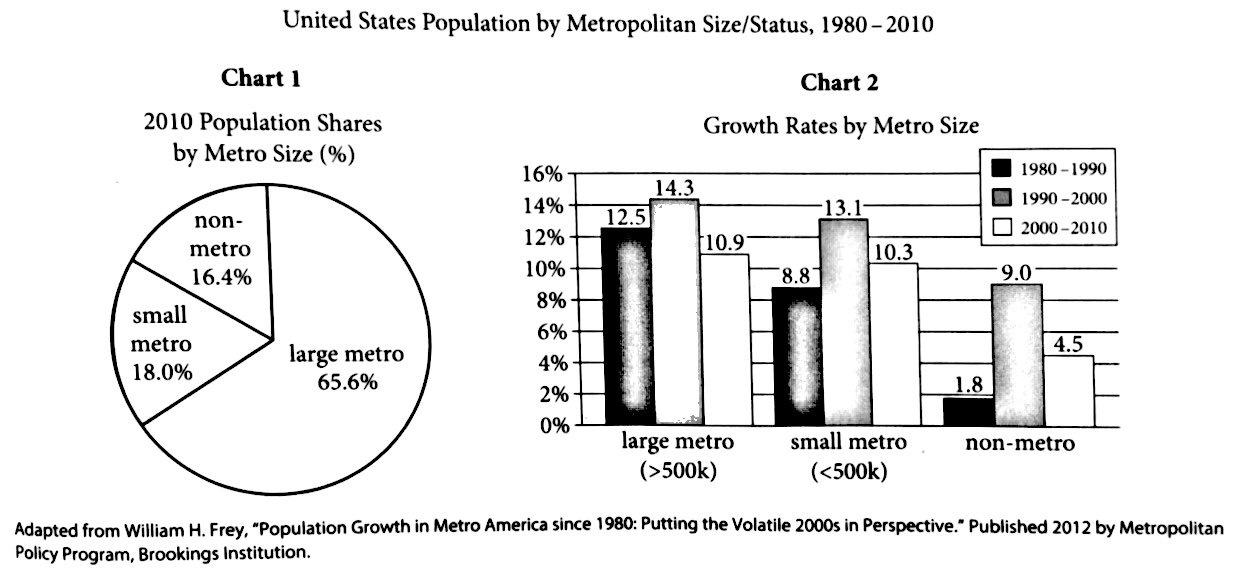Questions 11-21 are based on the following
passage.
This passage is adapted from Alan Ehrenhalt, The Great Inversion and the Future of the American City. ©2013 by Vintage.Ehrenhalt is an urbanologist—a scholar of cities and their development. Demographic inversion is a phenomenon that describes the rearrangement of living patterns throughout a metropolitan area.
We are not witnessing the abandonment of the
suburbs, or a movement of millions of people back to
the city all at once. The 2010 census certainly did not
turn up evidence of a middle-class stampede to the
5 nation’s cities.The news was mixed:Some of the
larger cities on the East Coast tended to gain
population, albeit in small increments.Those in the
Midwest,including Chicago, tended to lose
substantial numbers.The cities that showed gains in
10 overall population during the entire decade tended to
be in the South and Southwest.But when it comes to
measuring demographic inversion,raw census
numbers are an ineffective blunt instrument. A closer
look at the results shows that the most powerful
15 demographic events of the past decade were the
movement of African Americans out of centralcities
(180,000 of them in Chicago alone)and the
settlement of immigrant groups in suburbs,often
ones many miles distant from downtown.
20 Central-city areas that gained affluent residents in
the first part of the decade maintained that
population in the recession years from 2007 to 2009.
They also, according to a 2011 study by Brookings,
suffered considerably less from increased
25 unemployment than the suburbs did.Not many
young professionals moved to new downtown
condos in the recession years because few such
residences were being built.But there is no reason to
believe that the demographic trends prevailing prior
30 to the construction bust will not resume once that
bust is over. It is important to remember that
demographic inversion is not a proxy for population
growth; it can occur in cities that are growing, those
whose numbers are flat, and even in those
35 undergoing a modest decline in size.
America’s major cities face enormous fiscal
problems, many of them the result of public pension
obligations they incurred in the more prosperous
years of the past two decades. Some, Chicago
40 prominent among them,simply are not producing
enough revenue to support the level of public
services to which most of the citizens have grown to
feel entitled. How the cities are going to solve this
problem, I do not know. What I do know is that if
45 fiscal crisis were going to drive affluent professionals
out of central cities,it would have done so by now.
There is no evidence that it has.
The truth is that we are living at a moment in
which the massive outward migration of the affluent
50 that characterized the second half of the
twentieth century is coming to an end.And we need
to adjust our perceptions of cities,suburbs,and
urban mobility as a result.
Much of our perspective on the process of
55 metropolitan settlement dates, whether we realize it
or not,from a paper written in 1925 by the
University of Chicago sociologist Ernest W. Burgess.
It was Burgess who defined four urban/suburban
zones of settlement: a central business district; an
60 area of manufacturing just beyond it; then a
residential area inhabited by the industrial and
immigrant working class; and finally an outer
enclave of single-family dwellings.
Burgess was right about the urban America of
65 1925;he was right about the urban America of 1974.
Virtually every city in the country had a downtown,
where the commercial life of the metropolis was
conducted;it had a factory district just beyond; it had
districts of working-class residences just beyond that;
70 and it had residential suburbs for the wealthy and the
upper middle class at the far end of the continuum.
As a family moved up the economic ladder, it also
moved outward from crowded working-class
districts to more spacious apartments and,
75 eventually, to a suburban home.The suburbs of
Burgess’s time bore little resemblance to those at the
end of the twentieth century, but the theory still
essentially worked. People moved ahead in life by
moving farther out.
80 But in the past decade,in quite a few places,this
model has ceased to describe reality.There are still
downtown commercial districts, but there are no
factory districts lying next to them.There are
scarcely any factories at all.These close-in parts of
85 the city,whose few residents Burgess described as
dwelling in“submerged regions of poverty,
degradation and disease,”are increasingly the
preserve of the affluent who work in the commercial
core.And just as crucially newcomers to America are
90 not settling on the inside and accumulating the
resources to move out;they are living in the suburbs
from day one.